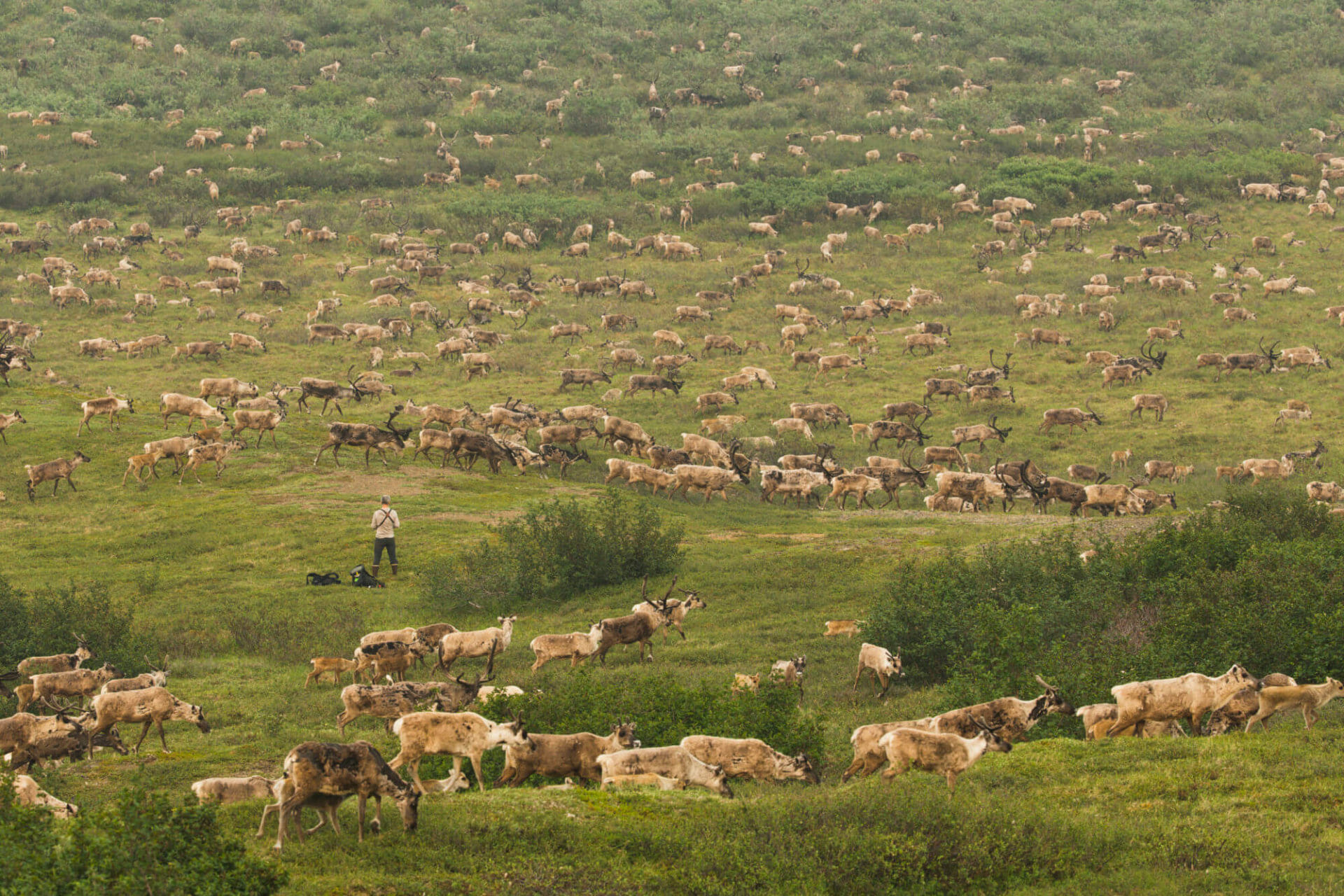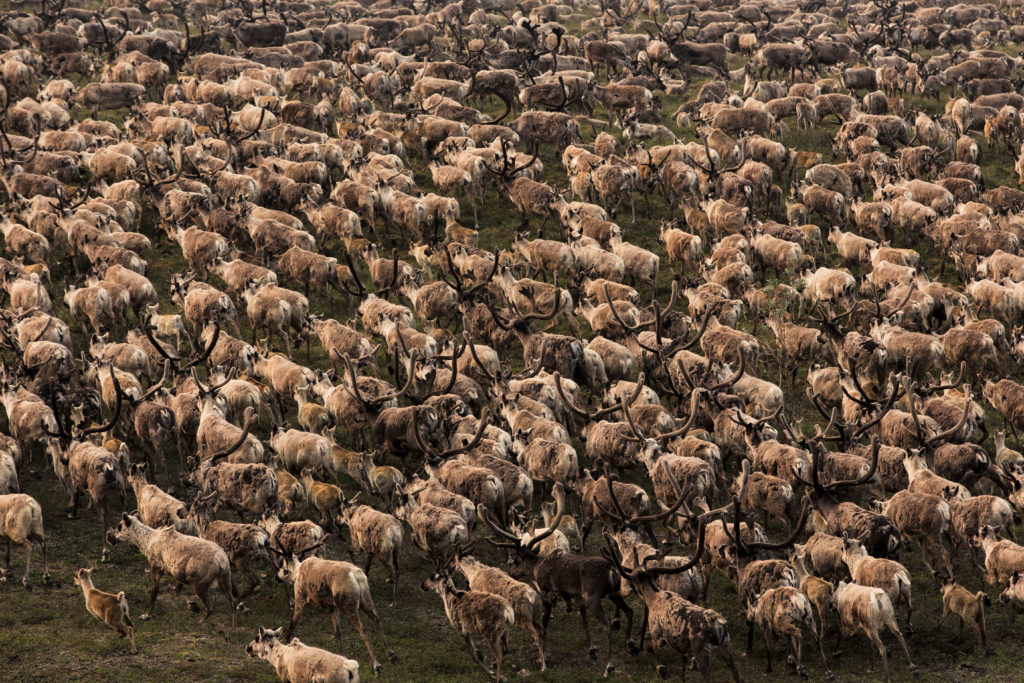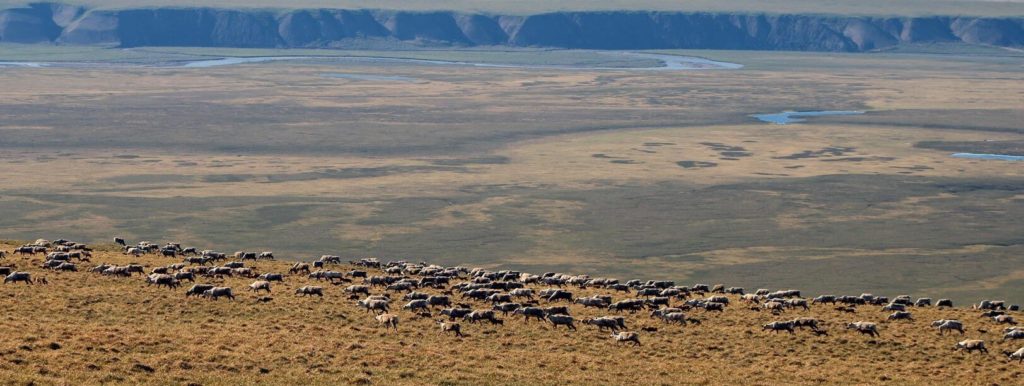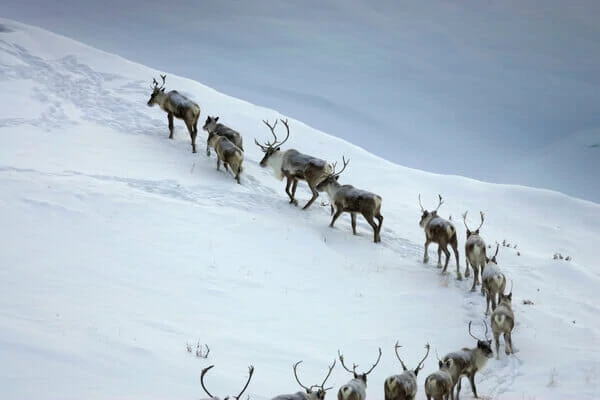Great herds of caribou are a powerful symbol of the Arctic, and camping amongst them is an experience of a lifetime. But their movements are erratic and notoriously hard to predict making it difficult to encounter this wildlife spectacle. After 20 years of guiding in northern Alaska we have developed several trips to help you see the herds. Here are 5 different trips, each with a different approach to finding caribou:
#1 – Mission: Caribou
When professional photographers and filmmakers like the BBC hire us to help them photograph big herds of caribou we stress the need for flexibility and air support. Migration patterns change year to year and caribou can move 50 miles in a day if pressed, so the most reliable way to experience the migration is to fly the general area where they were last seen seeking the densest concentrations, and then land in front of the herds. Once on the ground we set-up our base camp and then hike to a high point to get a good look before laboring across the tundra towards caribou in the distance. Sometimes caribou walk right into camp but more often we have to hike several miles across the tundra to meet them.
Usually this approach to finding caribou works. but sometimes we can’t find them from the air or can’t land near to them on our first try. In those cases we camp in the general area for a couple of days, enjoying all that the Arctic has to offer and then get the pilot to return so we can try again. Once we establish a second camp we resume the search on the ground for big herds. There are never any guarantees with wildlife and spending time in the Arctic with or without caribou is always a joy, but we have had fairly good luck showing people both the Western Arctic Herd and the Porcupine Herd with this general method.
#2 – Western Arctic Canoe Trip
For many visitors to Alaska, seeing herds of caribou is a high priority but not the entire goal of the trip. A river trip will never be the most reliable way to see caribou en masse, but there are a few areas where we regularly see caribou in good numbers year after year. In our experience the Western Arctic Herd is more predictable and more easily seen on a river trip than the Porcupine Herd in the east. Specifically there are a pair of lovely little rivers in the Western Brooks Range where we have had great luck finding huge groups of caribou and along with the caribou we often see predators like bears and wolves preying upon them. On one trip, year ago we had a bear kill a caribou calf within sight of camp and several years in a row we have seen 50,000 plus caribou on the river.
Another great canoe trip with very good chances for seeing big herds of caribou is in the famed Arctic National Wildlife Refuge. In early July the Porcupine Herd frequents the coast where cool breezes keep the bugs at bay. For the past several years the Canning River Delta has been popular with the herd and we have seen lots of cows and calves grazing here. With good forage and few insects these groups seem to be a bit more stationary than the rapidly migrating herds in June, giving us an opportunity to watch them for several days in a row. In addition to good chances for caribou, a canoe trip on the Canning River also offers world-class birding, great hiking in the mountains, and several historical sites.
#4 – Autumn Migration
The largest and densest herds form in late June and early July and are known as the “post calving aggregation” by biologists. If quantity is the goal, then that is the time to go. If, however, your goal is more aesthetic, then autumn can be an excellent time to observe and photograph caribou in the Brooks Range. With snow in the peaks, the tundra red, yellow and brown, and the aurora dancing in the twilight, the backdrop is stunning during late August and into September. Caribou are fat and healthy and their coats are a rich dark brown, bulls with white “beards” and striped flanks. We often see steady bands of caribou moving south through the mountains in groups of 10 to 50. Some years it is just a trickle, other years it is a steady flow of animals with band after band heading south. Timing and locations of the fall migration are even more variable than in the spring so flexibility in the location is key and a base camp trip gives the best chances for finding and seeing caribou.
#5 – Winter/ Spring
I’ve had some of my most memorable encounters with caribou when the snow covers the tundra and caribou are clothed in thick winter coats. In the dead of winter they are extremely shy and hard to observe but in late October during the rut, and again during the spring migration I’ve had very close encounters with caribou and seen decent sized herds packing long trails in the snow. The sounds of clashing antlers or hooves digging through the snow for lichens in the cold winter air is truly unique. Winter observations and photography can be accomplished from a heated winter base camp or if you want even more adventure we can arrange to use a dog team for local transport in an area where we hope to find caribou.
– To watch a valley fill with caribou, to awake in the pale midnight light to the sound of caribou grunting and bleating, to conceal yourself in the rocks as week-old caribou calves walk past at 20 yards totally unaware of your presence, or even to sit on a ridge top scanning the empty tundra trying in vain to find a single caribou in the immense wilderness; no matter the season or herd, and even if few caribou are seen, the search for caribou in the wilds of Alaska is reward in itself.









